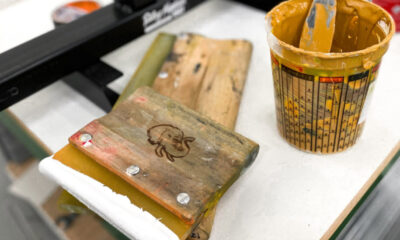Digital Printing
Published
12 years agoon

UV technology gives screen printers the capability to print faster, more efficiently, and more accurately on a wide range of materials. But to realize the full benefits of UV, users must understand the nature of UV inks and the equipment required to cure them.
UV technology gives screen printers the capability to print faster, more efficiently, and more accurately on a wide range of materials. But to realize the full benefits of UV, users must understand the nature of UV inks and the equipment required to cure them.
Resins give UV ink its major characteristics, such as adhesion and flexibility. Monomers are selected to dissolve the resins and pigments in the formula to a workable viscosity. They’re also selected to complement the resin in achieving the desired performance characteristics of cured or dry ink film. Additives contained in UV inks inlcude pigments (for color), flow agents, catalysts, and others. In UV inks, these catalysts are called photoinitiators. They absorb UV energy at certain wavelengths, creating free radicals that connect with the molecules of the resins and monomers and, in turn, cross-link with each other, forming chains of molecules we recognize as the cured ink film. Chemists call this cross-linking reaction polymerization. UV inks are considered 100% solids because almost everything in them is used up in the polymerization process.
One of the major advantages of UV over conventional inks is that no volatile organic compounds (VOCs) are released into the air during the curing process. In addition, UV curing relies on polymerization rather than evaporation, which means UV inks can be cured much more quickly and in less space than solvent-based inks. Finally, the lack of solvent in UV inks allows them to be used with higher mesh counts and support finer detail and higher print resolutions.
UV curing
The function of the curing unit is to deliver the UV energy that sets off the photoiniators and starts the polymerization process. However, before we ex-plore just how this energy is delivered, it might be beneficial to review the nature of electromagnetic energy. The UV range of the electromagnetic spectrum occurs at approximately 10-400 nm. The photoiniators used in UV inks typically react to specific wavelengths within the 200- to 400-nm range. However, the wavelengths that drive the curing reaction vary for different ink systems, which is why curing systems support different lamp types that deliver specific frequencies of UV energy.
For UV inks to cure properly, they must not only be exposed to the right wavelengths of UV energy, but also to the right amount of energy delivered at the correct intensity. The amount of energy arriving at the surface of the printed substrate is called the dose and is measured in millijoules (mJ/sq cm). The dose of energy a UV print receives is affected by the conveyor speed and number of lamps in the curing unit, as well as the number of times that it is exposed to the curing environment. The intensity of energy emitted by curing lamps is known as irradiance and is measured in watts or milliwatts (w/sq cm or mw/sq cm. Irradiance is directly related to electrical power, lamp condition, and the geometry of the reflector that directs and focuses the lamp output. Irradiance does not vary with exposure time.
The depth of cure achieved in the ink film is directly influenced by the irradiance level of the lamp. Delivering higher, more intense energy at the surface of the ink will allow more energy to penetrate the thickness of the ink film.
In curing units, the lamp and reflector assembly that delivers the UV light is call an irradiator. The lamps used in curing units generally consist of mercury vapor contained in a transparent quartz envelope. The lamps are powered in one of two ways. One type has electrodes at each end. When electrical current is applied, an arc is formed within the lamp, causing it to emit UV energy. The other type of lamp is electrodeless and ignites the gas with microwaves. In this system, a microwave-generating unit is placed above the irradiator and the microwaves are directed to the lamp by waveguides.
The medium-pressure mercury lamp is the most common lamp used for curing UV screen-printing inks. Argon gas and an exact amount of mercury (to create the right pressure when vaporized) are captured in a tube of fused silica. As Figure 1A shows, vaporized mercury emits ultraviolet energy at certain wavelengths so that when UV inks with the proper photoinitiators are exposed, cross-linking (curing) results.
Research has revealed that the addition of compounds called metal halides to the mercury enhances the spectral output of the lamp. This enhanced output is advantageous for curing opaque ink systems and those containing the white pigment titanium dioxide (TiO2). Two such doped lamps include the iron and gallium varieties (Figures 1B and 1C). Most curing units offered today are designed to allow lamps to be changed in a matter of minutes.
One factor that has the greatest impact on the curing efficiency of the lamp is the amount of electrical current that flows through it during operation. According to Ohm’s Law, volts x amps = watts. However, to calculate the actual power that the curing unit is receiving, watts must be multiplied by the power factor for the particular area (this factor can be supplied by the local electric company), and divided by the length of the lamp. The result is the exact power that the lamp is receiving, provided that there are no power fluctuations.
Curing units employ reflectors with different physical geometries to focus or scatter the lamp output across the print. The specific configuration of the reflector influences how the ink film is cured. Three main reflector geometries are used today: elliptical, which concentrates energy at the print surface with a narrow focal width; parabolic, which reflects energy at a slightly wider focal width; and multifaceted, which reflects energy at the widest focal width (Figure 2).
One final consideration about curing equipment concerns heat management. High temperature created by the IR energy UV lamps emit is an unfortunate byproduct of the curing process. Preventing this heat from building up and damaging sensitive substrates is a critical concern in UV curing. Systems for heat management in modern curing units include water cooling systems, fans, automatic shutter systems, and dichroic mirrors, which reflect UV but absorb IR energy.
Processing issues
Controlling UV-ink-film thickness in screen printing is of paramount importance. Mesh type, screen-tension level, emulsion thickness, and related screenmaking factors all contribute to the amount of ink deposited on the substrate. These variables have to be controlled to achieve the ink-film thickness recommended by the ink manufacturer. Similarly, press-setup parameters must also be controlled, including squeegee hardness, screen off-contact, and squeegee/floodbar speed and pressure.
The type of substrates you are printing on also influences the results you can expect from UV curing. On polycarbonate substrates, for example, UV energy at shorter wavelengths (below 300 nm) tends to affect the substrate surface. This phenomenon, known as photo-oxidation, appears as a gradual yellowing of the polycarbonate surface that occurs with repeated exposure to the UV energy.
The subtle change in the polycarbonate surface affects ink adhesion, especially when multiple colors are printed. However, the use of gallium lamps, which release UV energy in the shorter wavelength range, has been shown to minimize this photo-oxidation of polycarbonate.Polyester is another material commonly printed with UV. The main factor to keep in mind when working with polyester is that this material needs to be pretreated by flame or corona or coated with some form of primer to achieve good ink adhesion.
The last issue in using UV technology is safety. While UV inks aren’t characterized by dangerous solvents, the monomers they contain can cause allergic reactions in users who are sensitive to them. Monomers used in UV inks are tested for toxicity (skin irritation) and assigned a rating from one to ten, where one is least toxic and ten most toxic. But even with low-toxicity monomers, it is always a good idea to wear protective clothing, including eye and hand protection, when handling UV inks.
Besides UV energy, UV lamps also emit very bright visible light that could be harmful to the eyes if workers are exposed to it frequently or for long periods. This is why it is important to block light from escaping through the curing chamber’s conveyor openings by installing shields.
One other safety issue to keep in mind concerns ozone, which is a very unstable molecule of oxygen. Ozone is generated when an electric discharge passes through air or when oxygen is exposed to high-intensity UV energy. Ozone generated by curing units can lead to respiratory problems for those who work near the curing units, so it’s important to make sure that curing units are well vented to evacuate ozone from the work area.

Subscribe

Magazine
Get the most important news
and business ideas from Screenprinting Magazine.
Most Popular
-

 Art, Ad, or Alchemy1 month ago
Art, Ad, or Alchemy1 month agoF&I Printing Is Everywhere!
-

 Case Studies1 month ago
Case Studies1 month agoHigh-Density Inks Help Specialty Printing Take Center Stage
-

 Andy MacDougall1 month ago
Andy MacDougall1 month agoFunctional and Industrial Printing is EVERYWHERE!
-

 Columns2 weeks ago
Columns2 weeks ago8 Marketing Mistakes Not to Make When Promoting Your Screen Printing Services Online
-

 Editor's Note2 weeks ago
Editor's Note2 weeks agoLivin’ the High Life
-

 Thomas Trimingham2 months ago
Thomas Trimingham2 months ago“Magic” Marketing for Screen Printing Shops
-

 Marshall Atkinson2 weeks ago
Marshall Atkinson2 weeks agoHow to Create a Winning Culture in Your Screen-Printing Business
-

 News & Trends1 month ago
News & Trends1 month agoWhat Are ZALPHAS and How Can You Serve Them in Your Print Business?





